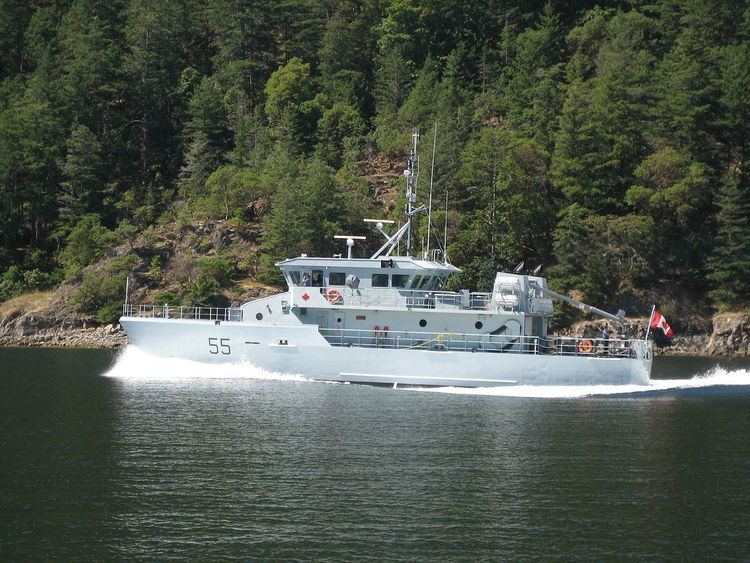Name Orca class Preceded by YAG 300 | ||
 | ||
Builders Victoria Shipyards, Esquimalt, BC Cost C$90.7 million (entire project) Built November 2004 – October 2008 | ||
The Orca class is a class of eight steel-hulled Royal Canadian Navy training tenders. Based on the Australian-designed Pacific-class patrol boat, the Orca class was constructed by Victoria Shipyards between November 2004 and November 2008, at a total project cost of C$90.7 million. All are in service at CFB Esquimalt in British Columbia. They replaced the YAG 300 class and operate as training platforms and surveillance craft. These ships are not commissioned and as such do not receive the prefix Her Majesty's Canadian Ship (HMCS).
Contents
Design and construction
During the early 2000s, the Canadian Forces Maritime Command, (MARCOM) began searching for a replacement for the 1950s-era wooden-hulled YAG 300 class training tenders. Training aboard these outdated vessels while useful, was less relevant as MARCOM moved the initial training of ship operators to modern land-based simulators that more accurately replicated the conditions aboard the Navy's capital ships. On 8 November 2004, the Department of National Defence announced a C$69.7 million contract for six new ships, with an option for two more, for a total budget of C$90.7 million.
The Orca-class ships are based on the Australian training vessel Seahorse Mercator, itself a derivative of the Australian-designed Pacific-class patrol boat. Though the two designs share a geometrically similar hull shape, much about the Orca-class design is different from its forebear. The Orca class has a 15% increase in hull displacement due to the requirement of the Royal Canadian Navy that the hull be able to withstand any increase in the size and weight of future equipment. This size change led to a change in the propulsion system, the system on Seahorse Mercator no longer providing the necessary speed. Other changes were made accommodation and bridge structure.
This also predicated a need to change the electrical systems and the installation of a third generator. The requirements of the Canadian Shipping Act meant that the electrical supply would be changed to 120 Volts/60 Hertz and that the water cooling system had to be redesigned. The addition of a hardened point for the possible installation of heavier armament required strengthening the foredeck and improving the fire protection. The installation of a new firemain supply to the new ammunition storage lockers required the redesign of several systems, among them the auxiliary seawater and bilge systems.
Each ship has a displacement of 210 tonnes, is 33 metres (108 ft) long, has a beam of 8.34 metres (27.4 ft), and a draught of 2.0 metres (6.6 ft). To meet the training requirement, the Orcas are fitted with a larger-than-normal bridge and carry warship-grade navigational equipment.
The Orcas are capable of 20 knots (37 km/h; 23 mph), and have an endurance of 660 nautical miles (1,220 km; 760 mi) at 15 knots (28 km/h; 17 mph). Propulsion is provided by two Caterpillar 3516B marine diesel engines, each rated for 2,500 horsepower at 1,600 revolutions per minute.
Each ship can be operated by a crew of five. Accommodation consists of two two-bunk cabins for the crew (Officer in Charge, Executive Officer, Senior Bosun's Mate (SBM), Orca Class Engineer (OCE)) two six bunk cabins and two four bunk cabins for 19 instructors and trainees for a total of 24 bunks.
The eight tenders were constructed by Victoria Shipyards at Victoria, British Columbia. The first ship in the class, Orca, was laid down in September 2005, launched in August 2006, and delivered to MARCOM in November 2006. Delivery of subsequent vessels was set to occur every three months. The project was completed when the eighth vessel, Moose, was delivered on 27 November 2008. The Orcas are not commissioned into service, so do not carry the HMCS ship prefix; instead, the prefix PCT (Patrol Craft Training) is carried.
Employment
The Orca class are designated as "Patrol Craft Training". The craft are primarily used to facilitate the various one-to-six-week long 'at sea' components of naval officer training. They are also used to train non-commissioned members and provide an at sea experience for the teenage members of the Royal Canadian Sea Cadets. Orcas are vessels of opportunity for surveillance and search and rescue. They are all homeported at CFB Esquimalt.
Three of the craft were temporarily fitted with .50-cal machine guns for port security during Operation PODIUM, the Canadian Forces' support of the 2010 Vancouver Winter Olympics. All eight vessels were constructed with a hardpoint designed for the fitting of a .50 calibre mounting, though none are currently fitted.
Names
In the early days of the Second World War, the Canadian Government acquired 14 large yachts for the Royal Canadian Navy. They ranged in age from seven to 39 years and were armed with a variety of weapons and given animal names. Five of them had served in the USN as auxiliary patrol craft from 1917 to 1919. Makeshift as they were, they shouldered the responsibility for local anti-submarine defence until in 1941 they were replaced by corvettes. They were then used as training and guard ships. All but Orca and Raven perpetuate the names of the armed yachts and all have a connection to First Nations lore. Cougar, Moose, and Wolf, are the third to carry those names as they also perpetuate the names of Fairmile Motor Launches. (Source: Acceptance Ceremony booklet)
